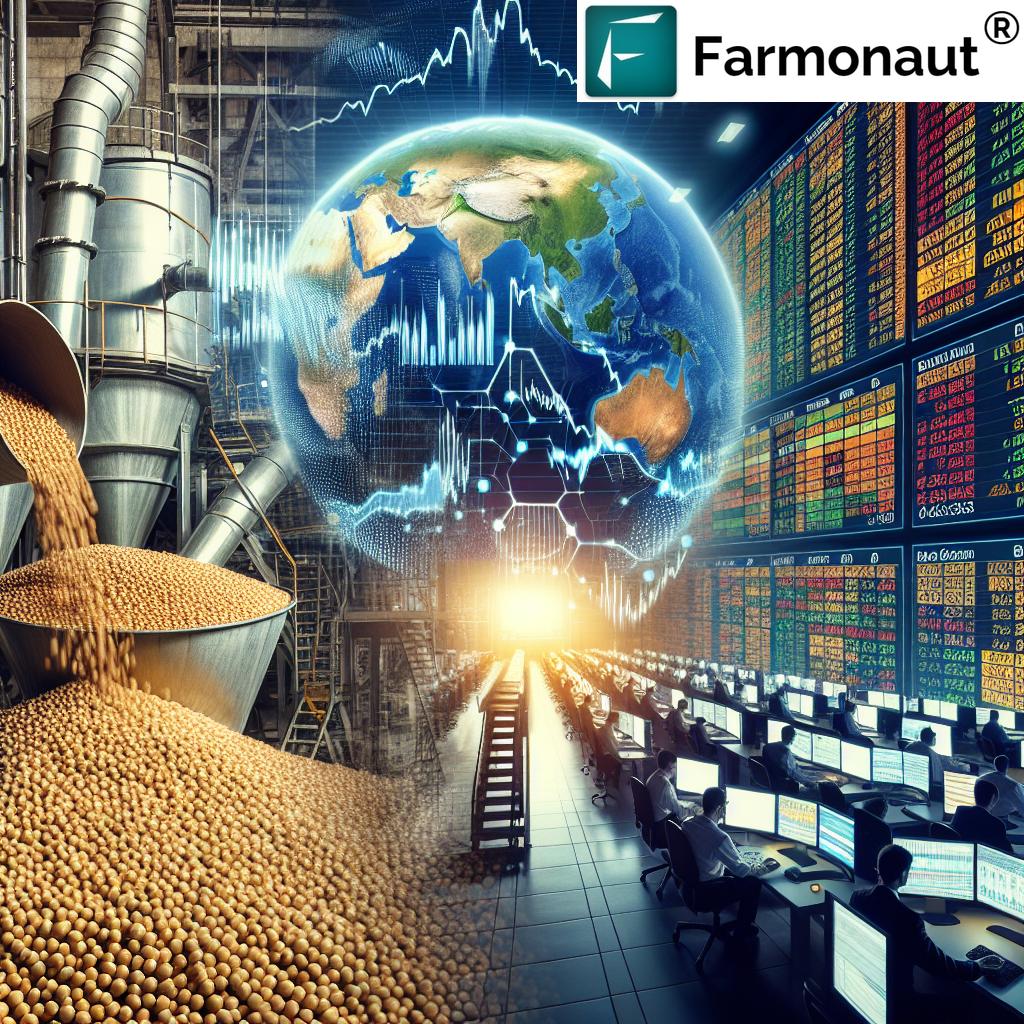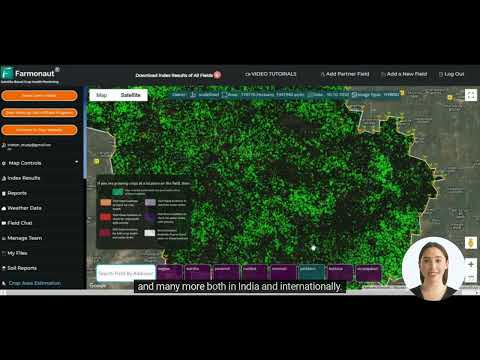Global Oilseed Market Analysis: Profitability Trends and Commodity Price Volatility in Agribusiness
In the ever-evolving landscape of global agribusiness, the oilseed market stands as a critical component of the consumer staples sector. This comprehensive analysis delves into the intricate world of vegetable oil industry performance, food commodities trading, and the financial metrics that drive agricultural stock performance. We’ll examine two major players in the oilseed processing and refining space, Australian Oilseeds (NASDAQ:COOT) and Bunge Global (NYSE:BG), to provide investors with valuable insights into this volatile yet essential industry.

“The global oilseed market’s volatility is reflected in a commodity price fluctuation of up to 30% annually.”
As we navigate through this analysis, we’ll explore crucial factors such as analyst recommendations, gross revenue, earnings per share, and market valuation. By examining risk factors, beta values, and return on equity, we aim to provide a comprehensive understanding of the dynamics shaping this industry. Let’s begin our journey into the world of oilseeds, where profitability trends and commodity price volatility intertwine to create a complex and fascinating market landscape.
Market Overview: The Global Oilseed Industry
The global oilseed market is a cornerstone of the agricultural sector, with far-reaching implications for food security, biofuel production, and industrial applications. Key players in this market focus on processing and refining various oilseeds, including soybeans, rapeseed, sunflower seeds, and palm oil. The industry’s performance is intricately tied to global economic conditions, weather patterns, and geopolitical factors that influence supply and demand dynamics.
In recent years, the oilseed market has experienced significant growth, driven by increasing population, changing dietary habits, and the rising demand for biofuels. However, this growth has been accompanied by heightened price volatility, presenting both opportunities and challenges for investors and industry participants alike.
Key Players: Australian Oilseeds and Bunge Global
To better understand the landscape of the global oilseed market, we’ll focus our analysis on two significant players: Australian Oilseeds and Bunge Global. Both companies operate within the consumer staples sector but exhibit distinct characteristics in terms of market position, financial performance, and strategic focus.
Australian Oilseeds (NASDAQ:COOT)
Australian Oilseeds Holdings Ltd. is a relatively new entrant to the public markets, having been founded on December 29, 2022. The company focuses on the manufacture and sale of oilseeds through its subsidiaries. While its operations are primarily centered in Australia, the company has ambitions for global expansion and diversification within the oilseed processing space.
Bunge Global (NYSE:BG)
Bunge Global SA, on the other hand, is a well-established player in the global agribusiness and food industry. With a history dating back to 1818, Bunge has evolved into a diversified company operating across four segments: Agribusiness, Refined and Specialty Oils, Milling, and Sugar and Bioenergy. The company’s global footprint and extensive product portfolio make it a formidable competitor in the oilseed market.
Comparative Analysis: Financial Metrics and Market Performance
To gain a deeper understanding of how these two companies stack up against each other, let’s examine key financial metrics and market performance indicators.
| Key Performance Indicator | Australian Oilseeds (COOT) | Bunge Global (BG) |
|---|---|---|
| Market Capitalization ($B) | 0.03 | 13.5 |
| Revenue Growth Rate (%) | N/A (New Listing) | 7.2 |
| Earnings Per Share ($) | N/A | 8.08 |
| Price-to-Earnings Ratio | N/A | 8.81 |
| Return on Equity (%) | N/A | 11.73 |
| Beta Value | -0.18 | 0.69 |
| Institutional Ownership (%) | 13.0 | 86.2 |
| Analyst Recommendations | No Coverage | 2.60 (Buy) |
| Biofuel Production Capacity (Million Gallons/Year) | N/A | ~500 |
| Global Market Share (%) | <1 | ~10 |
Market Capitalization and Scale: The stark difference in market capitalization highlights the vast gap in scale between the two companies. Bunge Global, with a market cap of $13.5 billion, dwarfs Australian Oilseeds’ $30 million valuation. This disparity reflects Bunge’s established position and global reach in the oilseed market.
Revenue and Profitability: While Australian Oilseeds is still in its early stages, with limited financial data available, Bunge Global demonstrates strong profitability metrics. Bunge’s earnings per share of $8.08 and a price-to-earnings ratio of 8.81 indicate a relatively undervalued stock compared to the broader market.
Return on Equity and Efficiency: Bunge Global’s return on equity of 11.73% suggests efficient use of shareholder capital, a crucial metric for investors in the capital-intensive agribusiness sector.
“Institutional ownership in major oilseed processing companies can exceed 70%, influencing stock performance and market trends.”
Institutional Ownership: The significant difference in institutional ownership (13% for Australian Oilseeds vs. 86.2% for Bunge Global) reflects the market’s confidence in Bunge’s established business model and future prospects. High institutional ownership often indicates a more stable stock price and better liquidity.
Risk and Volatility: The beta values of -0.18 for Australian Oilseeds and 0.69 for Bunge Global provide interesting insights into stock volatility. Australian Oilseeds’ negative beta suggests its stock price moves opposite to the broader market, potentially offering diversification benefits. Bunge’s beta of 0.69 indicates lower volatility compared to the market average, which may appeal to risk-averse investors.
Industry Trends and Market Dynamics
The global oilseed market is subject to various trends and dynamics that shape its future. Let’s explore some key factors influencing the industry:
- Increasing Demand for Plant-based Proteins: The rising popularity of plant-based diets is driving demand for oilseed-derived proteins, particularly soy and pea proteins. This trend benefits companies with diverse product portfolios in the oilseed space.
- Biofuel Production: The push for renewable energy sources continues to boost demand for oilseeds as feedstock for biodiesel production. Bunge Global’s significant biofuel production capacity positions it well to capitalize on this trend.
- Technological Advancements: Precision agriculture and data-driven farming practices are revolutionizing oilseed cultivation. Companies like Farmonaut are at the forefront of this transformation, offering satellite-based crop health monitoring and AI-driven advisory systems to optimize yields and resource management.
- Supply Chain Transparency: Consumers and regulators are increasingly demanding transparency in food supply chains. Blockchain-based traceability solutions, such as those offered by Farmonaut, are becoming crucial for oilseed processors to ensure product authenticity and build consumer trust.
- Climate Change and Sustainability: The oilseed industry faces challenges and opportunities related to climate change. Sustainable farming practices and carbon footprint reduction are becoming critical factors in company valuations and consumer preferences.

Commodity Price Volatility and Risk Management
The oilseed market is notorious for its price volatility, influenced by factors such as weather conditions, geopolitical events, and global supply-demand imbalances. Companies operating in this space must employ sophisticated risk management strategies to navigate these fluctuations.
Bunge Global’s diversified portfolio and global presence provide natural hedges against regional price fluctuations. The company’s integrated value chain, from sourcing to processing and distribution, allows for better control over costs and pricing power.
For smaller players like Australian Oilseeds, managing commodity price risk can be more challenging. However, the company’s focus on the Australian market may offer some insulation from global price swings, depending on local supply-demand dynamics.
Investors considering exposure to the oilseed market should be aware of these volatility factors and assess companies based on their risk management capabilities and financial resilience.
The Role of Technology in Oilseed Production and Processing
As the oilseed industry evolves, technology plays an increasingly crucial role in enhancing productivity, sustainability, and profitability. Companies that leverage cutting-edge technologies are better positioned to succeed in this competitive landscape.
Satellite-Based Crop Monitoring: Advanced platforms like Farmonaut offer real-time crop health monitoring using satellite imagery. This technology enables farmers and agribusinesses to optimize irrigation, fertilizer usage, and pest management, leading to improved yields and resource efficiency.
Artificial Intelligence in Agriculture: AI-driven advisory systems, such as Farmonaut’s Jeevn AI, provide personalized recommendations for crop management. These tools analyze vast amounts of data to deliver actionable insights, helping farmers make informed decisions and adapt to changing conditions.
Blockchain for Supply Chain Transparency: Blockchain technology is revolutionizing supply chain management in the oilseed industry. Farmonaut’s blockchain-based traceability solutions ensure transparency and authenticity throughout the production and distribution process, addressing growing consumer demands for product origin information.
Precision Agriculture: The integration of GPS technology, drones, and IoT sensors in farming equipment allows for precise application of inputs and targeted crop management. This level of precision contributes to cost reduction and environmental sustainability.
Companies that invest in these technologies and partner with agritech innovators like Farmonaut are likely to gain a competitive edge in the global oilseed market.
Investment Considerations and Future Outlook
When evaluating investment opportunities in the oilseed market, several factors should be considered:
- Market Position and Scale: Larger companies like Bunge Global offer stability and diversification, while smaller players like Australian Oilseeds may present growth opportunities in niche markets.
- Financial Health: Assess metrics such as debt-to-equity ratios, cash flow, and profitability margins to gauge a company’s financial resilience.
- Technological Adoption: Companies embracing advanced technologies for crop management, processing efficiency, and supply chain transparency are better positioned for long-term success.
- Sustainability Initiatives: With increasing focus on environmental, social, and governance (ESG) factors, companies with strong sustainability programs may attract more investor interest and customer loyalty.
- Geographic Diversification: Exposure to multiple regions can help mitigate risks associated with local market fluctuations or regulatory changes.
The future outlook for the global oilseed market remains positive, driven by population growth, increasing demand for plant-based proteins, and the expanding biofuel industry. However, challenges such as climate change, trade disputes, and regulatory pressures will continue to shape the industry landscape.
Conclusion: Navigating the Complex Oilseed Market
The global oilseed market presents a complex and dynamic investment landscape, characterized by commodity price volatility, technological disruption, and evolving consumer preferences. While established players like Bunge Global offer stability and scale, emerging companies such as Australian Oilseeds may provide opportunities for growth-oriented investors.
As the industry continues to evolve, the integration of advanced technologies will play a pivotal role in shaping market leaders. Platforms like Farmonaut, with their innovative approach to precision agriculture and supply chain transparency, are poised to become essential partners for oilseed producers and processors aiming to stay competitive in this challenging environment.
Investors considering exposure to the oilseed market should conduct thorough due diligence, considering not only financial metrics but also factors such as technological adoption, sustainability initiatives, and adaptability to market trends. By taking a holistic view of the industry and its key players, investors can make informed decisions in this essential component of the global agribusiness sector.
FAQ Section
- What are the main oilseeds traded in the global market?
The primary oilseeds traded globally include soybeans, rapeseed (canola), sunflower seeds, palm kernels, and cottonseed. - How does weather affect oilseed prices?
Weather conditions significantly impact crop yields, which in turn affect supply and prices. Droughts, floods, or extreme temperatures can lead to supply shortages and price spikes. - What role do biofuels play in the oilseed market?
Biofuels, particularly biodiesel, create substantial demand for oilseeds. Government mandates for renewable fuel use can significantly influence oilseed prices and production levels. - How can investors mitigate risks in the volatile oilseed market?
Investors can mitigate risks through diversification, investing in companies with strong risk management practices, and considering ETFs that track agricultural commodities or agribusiness stocks. - What are the emerging trends in oilseed processing technology?
Emerging trends include advanced extraction techniques for higher oil yields, enzyme technology for improved processing efficiency, and the development of specialty oils for specific industrial or nutritional applications.
For more information on how technology is revolutionizing the agricultural sector, including oilseed production, visit Farmonaut to explore their advanced farm management solutions.
Explore Farmonaut’s innovative agricultural solutions:
For developers interested in integrating agricultural data into their applications, check out Farmonaut’s API and API Developer Docs.
Earn With Farmonaut: Affiliate Program
Earn 20% recurring commission with Farmonaut’s affiliate program by sharing your promo code and helping farmers save 10%. Onboard 10 Elite farmers monthly to earn a minimum of $148,000 annually—start now and grow your income!
Farmonaut Subscriptions







